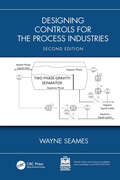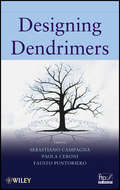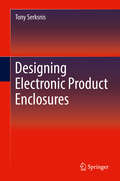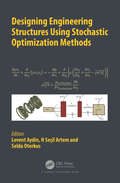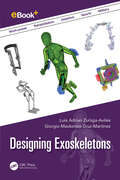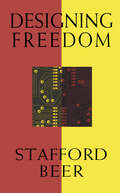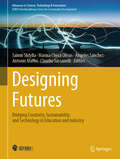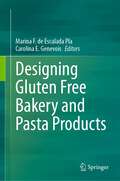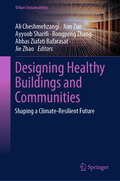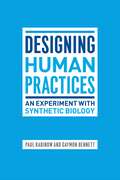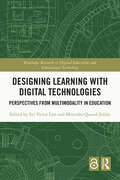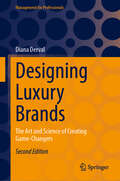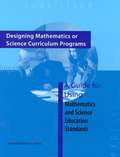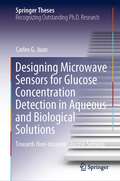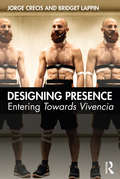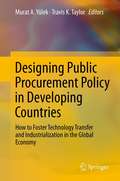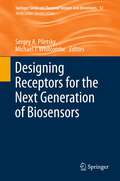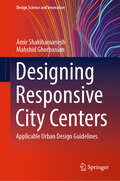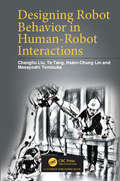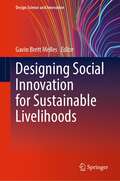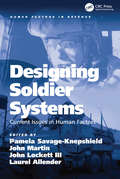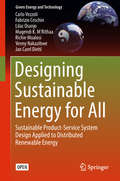- Table View
- List View
Designing Controls for the Process Industries
by Wayne SeamesOffering a modern, process-oriented approach emphasizing process control scheme development instead of extended coverage of LaPlace space descriptions of process dynamics, Designing Controls for the Process Industries focuses on aspects that are most important for contemporary practical process engineering and reflects the industry’s use of digital distributed control-based systems. The second edition now features 60 tutorial videos demonstrating solutions to most of the example problems. Instead of starting with the controller, the book starts with the process and moves on to how basic regulatory control schemes can be designed to achieve the process objectives while maintaining stable operations. In addition to continuous control concepts, process and control system dynamics are embedded into the text with each new concept presented. The book alsoincludes sections on batch and semi-batch processes and safety automation within each concept area. It discusses the four most common control techniques: control loop feedback, feedforward, ratio, and cascade, and discusses application of these techniques for process control schemes for the most common types of unit operations. It also discusses more advanced andless commonly used regulatory control options such as override, allocation, and split range controllers; includes an introduction to higher-level automation functions; and provides guidance for ways to increase the overall safety, stability, and efficiency for many process applications. It introduces the theory behind the most common types of controllers used in the process industries and provides various additional plant automation-related subjects. The new edition also includes new homework problems and examples, including multiple choice questions for flipped classes, information about statistical process control, and a new case study that documents the development of regulatory control schemes for an entire process area. Aimed at chemical engineering students in process control courses, as well as practicing process and control engineers, this textbook offers an alternative to traditional texts and offers a practical, hands-on approach to design of process controls. PowerPoint lecture slides, multiple-choice quiz questions for each chapter, and a solutions manual are available to qualifying instructors. Tutorial-style videos for most of the text examples are available for all readers to download.
Designing Dendrimers
by Sebastiano Campagna Fausto Puntoriero Paola CeroniResearch on dendrimers has exploded in the last 15 years, moving from the establishment of synthetic methodologies, particularly in the early years up to the end of nineties, towards sophisticated and wide-ranging applications. Dendrimers play an important role in many different areas, spanning from basic synthetic approaches to artificial photosynthesis, to medicine, to catalysis. The great potential of dendrimers is well-recognized by the hundreds of papers in the field and the increasing number of patents, and stimulated developments in other areas of knowledge, including new characterization techniques. However, some basic principles and methods still continue to give a unity to the field. Although several books on dendrimers have been published during these 15 years, the very recent progresses in new areas now requires a new point of view, trying to give a unifying and comprehensive outlook of the field. Since the first dendrimer was synthesized by Vögtle in 1978, dendrimers have experienced an explosion of scientific interest because of their unique molecular architecture. This resulted in over 5,000 scientific papers and patents published by the end of 2005. The proposed book will cover both fundamental and applicative aspects of dendrimer research. Chapters devoted to basic principles, synthetic methods and strategies, and advanced characterization techniques will be integrated by chapters illustrating the full potential of dendrimers in various fields, like artificial photosynthesis, multi-redox pool systems, diagnostics, biomedical and sensing purposes, design of functional nanostructures. Particular emphasis will be devoted to possible future developments.
Designing Digital Experiences For Positive Youth Development: From Playpen To Playground
by Marina Umaschi BersBased on over a decade and a half of research, Designing Digital Experiences for Positive Youth Development aims to guide readers in the design of digital technologies to promote positive behaviors in children and teenagers.
Designing Electronic Product Enclosures
by Tony SerksnisThis text explains the process of the design of product electronic enclosures. These products typically contain a printed circuit board. The text takes the reader from the original idea for a product, through the shipment in quantity to a customer. For the product enclosure designer, this proceeds through design layout, material selection, prototype building, testing, and ongoing design improvement. The book presents a substantive and lucid treatment of the structural, thermal, user-interface, assembly, quality control, and cost considerations of the product enclosure. Of special note is a discussion on the regulatory issues involved with the design of a product. A main thrust of the text is on the "commercialization" aspects of electronic products, that is, when an enclosure is needed for the product to meet environmental and certification requirements globally. The book targets the broadest audience tasked to design/manufacture an enclosure, from mechanical/industrial engineers to designers and technicians. While the intent of the text is not to provide a complete understanding of relevant physical phenomena addressed (strength of materials, shock and vibration, heat transfer), the book provides a ready reference on how and where these key properties may be considered in the design of most electronic enclosures.Elucidates successful enclosure design for electronic products, defining the design team and the definition of successExplains the processes for building enclosures, including printed circuit board layout (mechanical considerations) and optimal object placement, structural considerations, material selection, and user interface designIncludes treatment of serviceability, product environments, standards and testing, cooling techniques as well as guidelines for Electromagnetic Compliance (EMC) standards and testing required to pass FCC/CEReinforces design concepts presented with relevant solved problems
Designing Engineering Structures using Stochastic Optimization Methods
by Levent Aydin H Seçil Artem Selda OterkusAmong all aspects of engineering, design is the most important step in developing a new product. A systematic approach to managing design issues can only be accomplished by applying mathematical optimization methods. Furthermore, due to the practical issues in engineering problems, there are limitations in using traditional methods. As such, stochastic optimization methods such as differential evolution, simulated annealing, and genetic algorithms are preferable in finding solutions in design optimization problems. This book reviews mechanical engineering design optimization using stochastic methods. It introduces students and design engineers to practical aspects of complicated mathematical optimization procedures, and outlines steps for wide range of selected engineering design problems. It shows how engineering structures are systematically designed. Many new engineering design applications based on stochastic optimization techniques in automotive, energy, military, naval, manufacturing process and fluids-heat transfer, are described in the book. For each design optimization problem described, background is provided for understanding the solutions. There are very few books on optimization that include engineering applications. They cover limited applications, and that too of well-known design problems of advanced and niche nature. Common problems are hardly addressed. Thus, the subject has remained fairly theoretical. To overcome this, each chapter in this book is contributed by at least one academic and one industrial expert researcher.
Designing Exoskeletons
by Luis Adrian Zuñiga-Aviles Giorgio Mackenzie Cruz-MartinezDesigning Exoskeletons focuses on developing exoskeletons, following the lifecycle of an exoskeleton from design to manufacture. It demonstrates how modern technologies can be used at every stage of the process, such as design methodologies, CAD/CAE/CAM software, rapid prototyping, test benches, materials, heat and surface treatments, and manufacturing processes. Several case studies are presented to provide detailed considerations on developing specific topics. Exoskeletons are designed to provide work-power, rehabilitation, and assistive training to sports and military applications. Beginning with a review of the history of exoskeletons from ancient to modern times, the book builds on this by mapping out recent innovations and state-of-the-art technologies that utilize advanced exoskeleton design. Presenting a comprehensive guide to computer design tools used by bioengineers, the book demonstrates the capabilities of modern software at all stages of the process, looking at computer-aided design, manufacturing, and engineering. It also details the materials used to create exoskeletons, notably steels, engineering polymers, composites, and emerging materials. Manufacturing processes, both conventional and unconventional are discussed—for example, casting, powder metallurgy, additive manufacturing, and heat and surface treatments. This book is essential reading for those in the field of exoskeletons, such as designers, workers in research and development, engineering and design students, and those interested in robotics applied to medical devices.
Designing Freedom (The CBC Massey Lectures)
by Stafford BeerDistinguished cyberneticist Stafford Beer states the case for a new science of systems theory and cybernetics. His essays examine such issues as The Real Threat to All We Hold Most Dear, The Discarded Tools of Modern Man, A Liberty Machine in Prototype, Science in the Service of Man, The Future That Can Be Demanded Now, The Free Man in a Cybernetic World. Designing Freedom ponders the possibilities of liberty in a cybernetic world.
Designing Futures: Bridging Creativity, Sustainability, and Technology in Education and Industry (Advances in Science, Technology & Innovation)
by Angeles Sánchez Marina Checa Olivas Saimir Shtylla Antonio Maffei Claudio SassanelliThis book is a compelling exploration into the integration of sustainability with creativity and technology. It offers a cohesive journey from theoretical insights into practical applications across creative disciplines, education, and industries. This book serves as a crucial guide for those looking to navigate the challenges of modern sustainability through innovative solutions. By showcasing examples from 3D printing in education to sustainable practices in creative industries and the preservation of cultural heritage through digital innovation, it highlights the transformative power of creativity in fostering a sustainable future. Aimed at academics, professionals, and students, this book is an invitation to engage, innovate, and contribute to the sustainability discourse in the creative sectors.
Designing Gluten Free Bakery and Pasta Products
by Marina F. de Escalada Pla Carolina E. GenevoisThe ingestion of gluten in the human diet can lead to gastrointestinal disorders such as celiac disease, allergy to wheat and non-celiac gluten sensitivity. Currently the best treatment is the strict adherence to a diet without sources of prolamins and gliadins (wheat), secalin (rye) and hordein (barley). Several studies have revealed that a gluten-free diet may lead to nutrient deficiencies. Therefore, the formulation of gluten-free foods, particularly those related to cereals, is a major challenge. A great effort has been put into improved technological and nutritional aspects of gluten-free cereal products, as evidenced by the large amount of research published in journal articles. Thus far there has been no compilation of this up-to-date research which would lead to better implementation of healthy gluten-free products with improved technological and sensorial properties. Designing Gluten Free Bakery and Pasta Products provides a tool for designing gluten-free bakery and pasta products taking into account the most up-to-date advances and knowledge of gluten-related disorders , extensively covering both traditional and non-traditional gluten-free raw materials and bakery and pasta processes. This book will be particularly useful for food scientists and technologists developing gluten-free bakery and pasta products, plus physicians and nutritionists working with patients with gluten related diseases. This book covers new native/seasonal ingredients that improve the nutritional profile of baked goods, shelf life and starch retrogradation during storage, gluten-free edible film/toppings application, biotechnological pre-treatments of gluten-free flours and ingredients to enhance their technological/nutritional functionality, baked goods with spontaneous fermentation, sourdough from yeasts vs LAB present in gluten-free flours and effects on technological, nutritional and sensory characteristics. All these aspects were extensively discussed in this work, plus it provides a fully up-to-date studies on gluten-related health disorders and summarizes the main research advances in gluten-free product development and their market-related and industrial impact. This novel approach makes this book a unique and highly valuable resource for those on the forefront of gluten-free foods application.
Designing Healthy Buildings and Communities: Shaping a Climate-Resilient Future (Urban Sustainability)
by Jian Zuo Ali Cheshmehzangi Ayyoob Sharifi Rongpeng Zhang Abbas Ziafati Bafarasat Jie ZhaoThis book aims to explore and showcase global case studies focused on creating buildings and communities that promote health while enhancing climate resilience. In an era where climate change increasingly impacts urban environments, there is a critical need for innovative solutions that go beyond conventional practices. This book compiles a diverse range of examples, drawing on real-life projects and potential paradigm shifts that emphasise novel ideas and advanced methodologies. The featured case studies span various aspects of building and community design, including architectural design directions, technology integration, and technical methods. Each contribution provides practical examples that illustrate the implementation of these concepts in real-world settings. By highlighting innovative approaches, the book challenges the status quo and encourages a shift from business-as-usual scenarios to forward-thinking strategies that prioritise both human health and environmental sustainability. Key themes include the integration of green building technologies, the adoption of sustainable materials, and the incorporation of nature-based solutions in community design. Additionally, the book delves into community-driven initiatives that foster social cohesion and climate-resilience, demonstrating how collaborative efforts can lead to more robust and adaptable cities. Through detailed analyses and comprehensive discussions, this book serves as a vital resource for architects, urban planners, policymakers, and researchers. It provides insights into cutting-edge practices and offers inspiration for future projects aimed at creating a healthier and more sustainable future. By bringing together these global perspectives, the book highlights the importance of innovation and adaptability in the face of climate challenges, ultimately contributing to the development of sustainable and thriving urban landscapes.
Designing Human Practices: An Experiment with Synthetic Biology
by Paul Rabinow Gaymon BennettIn 2006 anthropologists Paul Rabinow and Gaymon Bennett set out to rethink the role that human sciences play in biological research, creating the Human Practices division of the Synthetic Biology Engineering Research Center—a facility established to create design standards for the engineering of new enzymes, genetic circuits, cells, and other biological entities—to formulate a new approach to the ethical, security, and philosophical considerations of controversial biological work. They sought not simply to act as watchdogs but to integrate the biosciences with their own discipline in a more fundamentally interdependent way, inventing a new, dynamic, and experimental anthropology that they could bring to bear on the center’s biological research. Designing Human Practices is a detailed account of this anthropological experiment and, ultimately, its rejection. It provides new insights into the possibilities and limitations of collaboration, and diagnoses the micro-politics which effectively constrained the potential for mutual scientific flourishing. Synthesizing multiple disciplines, including biology, genetics, anthropology, and philosophy, alongside a thorough examination of funding entities such as the National Science Foundation, Designing Human Practices pushes the social study of science into new and provocative territory, utilizing a real-world experience as a springboard for timely reflections on how the human and life sciences can and should transform each other.
Designing Human Practices: An Experiment with Synthetic Biology
by Paul Rabinow Gaymon BennettIn 2006 anthropologists Paul Rabinow and Gaymon Bennett set out to rethink the role that human sciences play in biological research, creating the Human Practices division of the Synthetic Biology Engineering Research Center—a facility established to create design standards for the engineering of new enzymes, genetic circuits, cells, and other biological entities—to formulate a new approach to the ethical, security, and philosophical considerations of controversial biological work. They sought not simply to act as watchdogs but to integrate the biosciences with their own discipline in a more fundamentally interdependent way, inventing a new, dynamic, and experimental anthropology that they could bring to bear on the center’s biological research.Designing Human Practices is a detailed account of this anthropological experiment and, ultimately, its rejection. It provides new insights into the possibilities and limitations of collaboration, and diagnoses the micro-politics which effectively constrained the potential for mutual scientific flourishing. Synthesizing multiple disciplines, including biology, genetics, anthropology, and philosophy, alongside a thorough examination of funding entities such as the National Science Foundation, Designing Human Practices pushes the social study of science into new and provocative territory, utilizing a real-world experience as a springboard for timely reflections on how the human and life sciences can and should transform each other.
Designing Learning with Digital Technologies: Perspectives from Multimodality in Education (Routledge Research in Digital Education and Educational Technology)
by Fei Victor Lim Mercedes Querol-JuliánThis book offers a multimodal perspective on how to design meaningful learning experiences with digital technologies.Digital education is of increasing importance in today’s digital society and the editors bring together international thought-leaders and well-established academics across geographical regions to explore the topic. The book addresses the need to design learning with digital technologies, especially in a post-pandemic environment where blended learning has become ubiquitous. The book is organised around five themes: designing learning, digital learning designs, digital learning with embodied teaching, digital learning interactions, and digital multimodal literacies. The chapters focus on digital technologies as multimodal semiotic resources and the educational implication of each theme is drawn out from illustrative cases across contexts of learning.Essential reading for researchers and postgraduate students, this book offers state-of-the-art thinking on how educators can design new learning experiences for students through the meaningful and effective use of digital technologies.Chapter 1 of this book is freely available as a downloadable Open Access PDF at http://www.taylorfrancis.com under a Creative Commons Attribution-Non Commercial-No Derivatives (CC-BY-NC-ND) 4.0 license.
Designing Luxury Brands: The Art and Science of Creating Game-Changers (Management for Professionals)
by Diana DervalThis book, a second offering after the successful first edition, shows how to build successful luxury brands using the power of sensory science and neuropsychology. The author presents inspiring business cases like Tesla Cybertruck, Chanel, KaDeWe, Baccarat, JACQUEMUS, NASA, MUD Jeans, Lilium, Rémy Cointreau, FENG J, Moncler, Louboutin, or Raffles Dubai in industries such as Fashion, Automotive or Leisure. The book highlights groundbreaking scientific methods - like the Derval Color Test® taken by over 30 million people - to help predict luxury shoppers’ preferences and purchasing patterns. Game-changing and unique features of successful luxury brands are decoded. Through various practical examples and experiments, readers will be able to build, revamp, or expand luxury brands and look at luxury from a new angle.
Designing Mathematics or Science Curriculum Programs: A Guide for Using Mathematics and Science Education Standards
by Committee on Science Education K-12 the Mathematical Sciences Education BoardWith the publication of the National Science Education Standards and the National Council of Teachers of Mathematics' Curriculum and Evaluation Standards for School Mathematics, a clear set of goals and guidelines for achieving literacy in mathematics and science was established. Designing Mathematics or Science Curriculum Programs has been developed to help state- and district-level education leaders create coherent, multi-year curriculum programs that provide students with opportunities to learn both mathematics and science in a connected and cumulative way throughout their schooling.Researchers have confirmed that as U.S. students move through the grade levels, they slip further and further behind students of other nations in mathematics and science achievement. Experts now believe that U.S. student performance is hindered by the lack of coherence in the mathematics and science curricula in many American schools. By structuring curriculum programs that capitalize on what students have already learned, the new concepts and processes that they can learn will be richer, more complex, and at a higher level. Designing Mathematics or Science Curriculum Programs outlines: Components of effective mathematics and science programs. Criteria by which these components can be judged. A process for developing curriculum that is structured, focused, and coherent. Perhaps most important, this book emphasizes the need for designing curricula across the entire 13-year span that our children spend in elementary and secondary school as a way to improve the quality of education. Ultimately, it will help state and district educators use national and state standards to design or re-build mathematics and science curriculum programs that develop new ideas and skills based on earlier ones--from lesson to lesson, unit to unit, year to year.Anyone responsible for designing or influencing mathematics or science curriculum programs will find this guide valuable.
Designing Microwave Sensors for Glucose Concentration Detection in Aqueous and Biological Solutions: Towards Non-invasive Glucose Sensing (Springer Theses)
by Carlos G. JuanThis book presents a comprehensive study covering the design and application of microwave sensors for glucose concentration detection, with a special focus on glucose concentration tracking in watery and biological solutions. This book is based on the idea that changes in the glucose concentration provoke variations in the dielectric permittivity of the medium. Sensors whose electrical response is sensitive to the dielectric permittivity of the surrounding media should be able to perform as glucose concentration trackers. At first, this book offers an in-depth study of the dielectric permittivity of water–glucose solutions at concentrations relevant for diabetes purposes; in turn, it presents guidelines for designing suitable microwave resonators, which are then tested in both water–glucose solutions and multi-component human blood plasma solutions for their detection ability and sensitivities. Finally, a portable version is developed and tested on a large number of individuals in a real clinical scenario. All in all, the book reports on a comprehensive study on glucose monitoring devices based on microwave sensors. It covers in depth the theoretical background, provides extensive design guidelines to maximize sensitivity, and validates a portable device for applications in clinical settings.
Designing Presence: Entering Towards Vivencia
by Jorge Crecis Bridget LappinDesigning Presence offers a unique insight into the training that has helped people around the world to cultivate more presence in both professional and personal settings. It explains the research behind the method of Towards Vivencia, shares stories of how it has been implemented and offers practical exercises to apply it in any context. Presence is something that is often talked about but is difficult to pin down. We have all experienced moments when we felt one with what we are doing and with our environment. However, this feeling is usually fleeting and we don’t know when or how we will experience it again. Towards Vivencia is the first methodology of its kind to train performers to locate and replicate that specific state of consciousness associated with presence and peak performance. Based on over 20 years of experience, combined with research in anthropology, philosophy and the latest advances in neuroscience, Towards Vivencia enables performers to become fully engaged with their experience in order to operate at their highest possible level. This book aims to equip readers with the ability to actively design their experiences and create lasting changes not only in how they approach performance but also how they approach their everyday lives.
Designing Public Procurement Policy in Developing Countries
by Travis K. Taylor Murat A. YülekThis book presents effective strategies for developing countries to leverage their public sector demand for manufactured imports to promote industrialization, trade, and technology transfer. Technology transfer and its absorption is considered one of the most crucial and complicated challenges for developing countries, which are characterized by insufficient infrastructure, low technological intensity of the domestic capital stock, and high levels of manufactured imports. Which strategies and policy tools can governments employ to link demand with technology transfer, thereby enhancing absorption capacity and development in emerging economies? This book is part of a broader project launched by PGlobal Global Advisory and Training Services Ltd., in cooperation with Istanbul Commerce University (İTUCU) and the Scientific and Technological Research Council of Turkey (TÜBİTAK). The contributors to this book are policymakers, academicians, and experts who are working together to identify problems and develop policy recommendations for public procurement with respect to economic development. The book includes theoretical, empirical, and case study analyses of technology transfer mechanisms, public procurement policies, and countertrade and offset strategies. The lessons learned from these chapters will be of interest to both academics and policymakers concerned with technology transfer, industrial policy, and economic development.
Designing Receptors for the Next Generation of Biosensors
by Michael J. Whitcombe Sergey A. PiletskyDespite achievements in the application of enzymes, antibodies and biological receptors to diagnostics and sensing, the last two decades have also witnessed the emergence of a number of alternative technologies based on synthetic chemistry. This volume shows how synthetic receptors can be designed with characteristics that make them attractive alternatives to biological molecules in the sensory and diagnostics fields, with contributions from leading experts in the area. Subjects covered include synthetic receptors for a range of biomolecules, the use of antimicrobial peptides for the detection of pathogenic microorganisms, the development of molecularly imprinted polymer (MIP) nanoparticles, the in silico design of MIPs and MIP-based sensors, and two chapters examining the development of sensors from an industrial point of view. The particular focus of all chapters is on practical aspects, either in the development process or the applications of the synthesized materials. This book will serve as an important reference work for business leaders and technology experts in the sensors and diagnostics sector.
Designing Renewable Energy Systems within Planetary Boundaries: A Textbook for Energy Engineers (Green Energy and Technology)
by Mika Järvinen Hanna PaulomäkiThis open access book explores interdisciplinary sustainability for energy engineering students. Future generations of engineers need to be game changers. The book is designed to help future engineers redesign the world, avoid harmful lockdowns, and prevent the creation of new problems while transforming energy systems in economically profitable and ecologically sustainable ways. It explains the principles of planetary boundaries, addressing the most relevant ones throughout. The book's focus is on the primary methods for producing renewable power and heating. It discusses the fundamental technical and economic design principles involved. The book also covers key energy storage solutions and includes an overview of the impacts of renewable energy production on ecosystems. The book also serves as a useful guide for engineers working on renewable energy projects.
Designing Responsive City Centers: Applicable Urban Design Guidelines (Design Science and Innovation)
by Amir Shakibamanesh Mahshid GhorbanianThis book explores the history and evolution of city centers and provides practical guidance for designing successful city centers, emphasizing the importance of urban design guidelines in achieving this goal. With a focus on community engagement, environmental quality, and economic benefits, the book offers a roadmap for creating vibrant, dynamic, and sustainable city centers that enhance the overall quality of life for their communities. The book offers guidelines for urban design, which can be used to apply the main principles and solutions related to landscaping, building architecture, and access systems. The guidelines manifest development policies as key solutions and govern the qualitative aspects of the plan, enabling the creation of responsive city centers that benefit their communities. An invaluable resource for anyone interested in urban design and its role in shaping the cities of the future, this book is an essential tool for creating successful and sustainable urban environments.
Designing Robot Behavior in Human-Robot Interactions
by Changliu Liu Te Tang Hsien-Chung Lin Masayoshi TomizukaIn this book, we have set up a unified analytical framework for various human-robot systems, which involve peer-peer interactions (either space-sharing or time-sharing) or hierarchical interactions. A methodology in designing the robot behavior through control, planning, decision and learning is proposed. In particular, the following topics are discussed in-depth: safety during human-robot interactions, efficiency in real-time robot motion planning, imitation of human behaviors from demonstration, dexterity of robots to adapt to different environments and tasks, cooperation among robots and humans with conflict resolution. These methods are applied in various scenarios, such as human-robot collaborative assembly, robot skill learning from human demonstration, interaction between autonomous and human-driven vehicles, etc. Key Features: Proposes a unified framework to model and analyze human-robot interactions under different modes of interactions. Systematically discusses the control, decision and learning algorithms to enable robots to interact safely with humans in a variety of applications. Presents numerous experimental studies with both industrial collaborative robot arms and autonomous vehicles.
Designing Social Innovation for Sustainable Livelihoods (Design Science and Innovation)
by Gavin Brett MellesThis volume discusses how design broadly understood as design of business, policy, product, system, etc. can produce socially responsible innovations with livelihoods consequences. Sustainable Livelihoods Framework (SLF) is a robust framework for analysing and measuring social impact for excluded populations and groups. This is illustrated with case studies from India, Sri Lanka, Bangladesh, Nepal by discussing how initiatives concerned with design in the broad sense have the potential to create sustainable livelihoods. This volume will be of interest to scholars and practitioners in Sustainable Development and Design.
Designing Soldier Systems: Current Issues in Human Factors (Human Factors in Defence)
by John Martin Pamela Savage-Knepshield John Lockett III Laurel AllenderThis book focuses on contemporary human factors issues within the design of soldier systems and describes how they are currently being investigated and addressed by the U.S. Army to enhance soldier performance and effectiveness. Designing Soldier Systems approaches human factors issues from three main perspectives. In the first section, Chapters 1-5 focus on complexity introduced by technology, its impact on human performance, and how issues are being addressed to reduce cognitive workload. In the second section, Chapters 6-10 concentrate on obstacles imposed by operational and environmental conditions on the battlefield and how they are being mitigated through the use of technology. The third section, Chapters 11-21, is dedicated to system design and evaluation including the tools, techniques and technologies used by researchers who design soldier systems to overcome human physical and cognitive performance limitations as well as the obstacles imposed by environmental and operations conditions that are encountered by soldiers. The book will appeal to an international multidisciplinary audience interested in the design and development of systems for military use, including defense contractors, program management offices, human factors engineers, human system integrators, system engineers, and computer scientists. Relevant programs of study include those in human factors, cognitive science, neuroscience, neuroergonomics, psychology, training and education, and engineering.
Designing Sustainable Energy for All: Sustainable Product-service System Design Applied To Distributed Renewable Energy (Green Energy and Technology)
by Jan Carel Diehl Fabrizio Ceschin Carlo Vezzoli Lilac Osanjo Mugendi K. M’Rithaa Richie Moalosi Venny NakazibweThis open access book addresses the issue of diffusing sustainable energy access inlow- and middle-income contexts.Access to energy is one of the greatest challenges for many people living in low-income and developing contexts, as around 1.4 billion people lack access to electricity.Distributed Renewable Energy systems (DRE) are considered a promising approachto address this challenge and provide energy access to all. However, even if promising,the implementation of DRE systems is not always straightforward.The book analyses, discusses and classifies the promising Sustainable Product-ServiceSystem (S.PSS) business models to deliver Distributed Renewable Energy systems in aneffective, efficient and sustainable way. Its message is supported with cases studies andexamples, discussing the economic, environmental and socioethical benefits as wellas its limitations and barriers to its implementation. An innovative design approach isproposed and a set of design tools are supplied, enabling readers to create and developSustainable Product-Service System (S.PSS) solutions to deliver Distributed RenewableEnergy systems.Practical applications of the book’s design approach and tools by companies andpractitioners are discussed and the book will be of interest to readers in design, industry,governmental institutions, NGOs as well as researchers.
